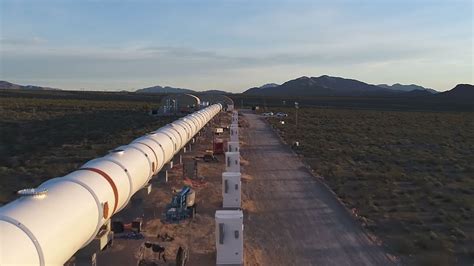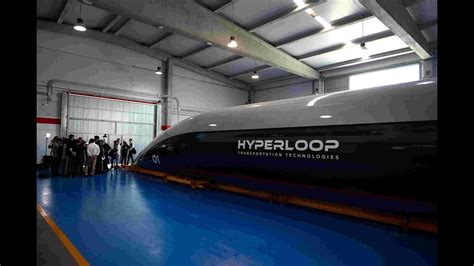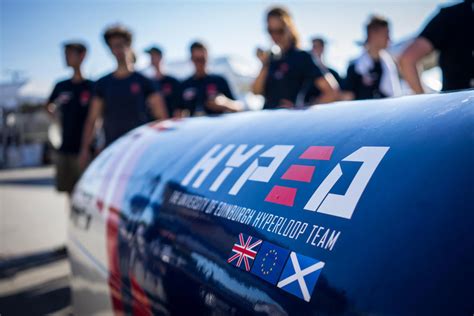What is the Hyperloop?
The Hyperloop is a proposed high-speed transportation system that would send passengers and cargo through low-pressure tubes at speeds over 700 mph. The concept was first proposed by Elon Musk, CEO of SpaceX and Tesla, in a 2013 white paper. Musk envisioned the Hyperloop as a fast, efficient, and sustainable alternative to current modes of transportation like cars, trains, and planes.
The key components of a Hyperloop system include:
| Component | Description |
|---|---|
| Tubes | Low-pressure tubes that provide a controlled environment for the pods to travel through |
| Pods | Passenger or cargo vehicles that levitate and move through the tubes using magnetic propulsion |
| Compressors | Devices that pump air from the front to the rear of the pods to reduce air resistance |
| Propulsion | Linear induction motors that accelerate and decelerate the pods |
| Levitation | Magnetic or air bearings that allow the pods to float above the track and minimize friction |
By combining these elements, the Hyperloop aims to achieve the following benefits compared to existing transportation technologies:
| Benefit | Hyperloop | High-Speed Rail | Air Travel |
|---|---|---|---|
| Speed | 700+ mph | 150-200 mph | 500+ mph |
| Efficiency | High | Medium | Low |
| Emissions | Zero | Medium | High |
| Infrastructure Cost | Low-Medium | High | Medium-High |
While the Hyperloop is still in the early stages of development, several companies and organizations are actively working on advancing the technology, including SpaceX.
The SpaceX Hyperloop Pod Competition
To accelerate the development of Hyperloop technology, SpaceX launched the Hyperloop Pod Competition in 2015. The competition challenges university students and independent engineering teams to design and build high-speed pods that could potentially be used in a Hyperloop system.
The primary goals of the Hyperloop Pod Competition are to:
- Encourage innovation in Hyperloop design and engineering
- Provide a platform for hands-on experience and learning
- Identify promising Hyperloop concepts and technologies
- Promote collaboration and knowledge-sharing among teams
The competition has been held annually since 2017, with each year focusing on different aspects of pod design and performance.
| Year | Focus |
|---|---|
| 2017 | Overall pod design and performance |
| 2018 | Maximum speed with self-propulsion |
| 2019 | Maximum speed with self-propulsion and self-navigation |
Teams from around the world have participated in the Hyperloop Pod Competition, representing top universities and engineering programs. Some notable teams and their achievements include:
| Team | University | Notable Achievement |
|---|---|---|
| Warr Hyperloop | Technical University of Munich | Fastest pod in 2018 (290 mph) and 2019 (463 mph) |
| Delft Hyperloop | Delft University of Technology | Winner of the Innovation Award in 2017 |
| MIT Hyperloop | Massachusetts Institute of Technology | Fastest pod in 2017 (240 mph) |
| Badgerloop | University of Wisconsin-Madison | 3rd place in 2017 and Levitation Award in 2018 |
These teams have not only achieved impressive results in the competition but have also contributed to advancing Hyperloop technology through their innovative designs and engineering solutions.

Electronics Design in the Hyperloop Pod Competition
One of the key areas where teams have focused their efforts in the Hyperloop Pod Competition is electronics design. The pods require sophisticated control systems, sensors, and power electronics to achieve high speeds and safe operation.
Some of the main electronic subsystems in a Hyperloop pod include:
Propulsion System
The propulsion system is responsible for accelerating and decelerating the pod. Most teams have used linear induction motors (LIMs) for propulsion, which require power electronics to control the motor currents and generate the necessary magnetic fields.
Levitation System
The levitation system allows the pod to float above the track and minimize friction. Teams have explored various levitation technologies, including passive magnetic levitation (maglev), active maglev, and air bearings. Each approach requires specific electronic controls and sensors to maintain stable levitation.
Braking System
The braking system is critical for safely decelerating the pod, especially in case of emergencies. Teams have implemented a combination of regenerative braking, eddy current braking, and friction braking. The braking system requires precise control electronics to coordinate the different braking mechanisms and ensure smooth deceleration.
Navigation and Communication System
The navigation and communication system enables the pod to determine its position, speed, and orientation within the tube and communicate with the control center. Teams have used a variety of sensors, such as inertial measurement units (IMUs), encoders, and laser rangefinders, along with wireless communication technologies to achieve reliable navigation and telemetry.
Battery Management System (BMS)
The BMS is responsible for monitoring and managing the pod’s battery pack, which provides power to all the electronic subsystems. The BMS ensures safe and efficient operation of the batteries, including charge balancing, temperature monitoring, and fault protection.
Designing and integrating these electronic subsystems requires a deep understanding of power electronics, control systems, embedded software, and PCB design. The Hyperloop Pod Competition provides a unique opportunity for students and young engineers to gain hands-on experience in these areas and develop their skills in a challenging and fast-paced environment.

Impact of the Hyperloop Pod Competition on Electronics Education
The Hyperloop Pod Competition has had a significant impact on electronics education, both at the university level and beyond. By participating in the competition, students gain practical experience in designing, building, and testing complex electronic systems that must perform under real-world conditions.
Some of the key benefits of the competition for electronics education include:
Project-Based Learning
The competition provides a structured, project-based learning experience that allows students to apply their theoretical knowledge to a concrete engineering challenge. This approach has been shown to improve student engagement, motivation, and retention of knowledge compared to traditional lecture-based instruction.
Interdisciplinary Collaboration
Building a Hyperloop pod requires expertise in multiple engineering disciplines, including mechanical, electrical, and software engineering. The competition encourages students to work in interdisciplinary teams, fostering collaboration and communication skills that are essential in modern engineering practice.
Industry Exposure
The competition attracts sponsors and partners from leading technology companies, such as SpaceX, Tesla, and Dassault Systèmes. By interacting with industry professionals and showcasing their work, students gain visibility and networking opportunities that can lead to internships, job offers, and research collaborations.
Skills Development
Participating in the competition helps students develop a wide range of technical and professional skills, such as:
- PCB design and fabrication
- Embedded software development
- Control system design and tuning
- Sensor integration and data acquisition
- Battery management and power electronics
- Project management and teamwork
- Technical writing and presentation
These skills are highly valued by employers in the electronics industry and can give students a competitive edge when entering the job market.
Innovation and Entrepreneurship
The Hyperloop Pod Competition encourages students to think creatively and develop innovative solutions to complex engineering problems. Many teams have gone on to form startups or pursue further research based on their work in the competition, contributing to the growth of the Hyperloop ecosystem and the broader transportation industry.

Conclusion
The SpaceX Hyperloop Pod Competition has emerged as a powerful platform for growing the next generation of electronics designers. By providing a challenging and immersive learning experience, the competition helps students develop the technical skills, interdisciplinary knowledge, and professional competencies needed to succeed in the rapidly evolving field of electronics engineering.
As the Hyperloop continues to gain momentum as a potential transportation solution, the importance of skilled electronics designers will only continue to grow. The Hyperloop Pod Competition is playing a crucial role in meeting this demand by inspiring and preparing talented young engineers to take on the challenges of building the transportation systems of the future.
FAQ
1. What is the purpose of the SpaceX Hyperloop Pod Competition?
The SpaceX Hyperloop Pod Competition aims to accelerate the development of Hyperloop technology by challenging university students and independent engineering teams to design and build high-speed pods that could potentially be used in a Hyperloop system.
2. What are the main electronic subsystems in a Hyperloop pod?
The main electronic subsystems in a Hyperloop pod include the propulsion system, levitation system, braking system, navigation and communication system, and battery management system (BMS).
3. How has the Hyperloop Pod Competition impacted electronics education?
The competition has impacted electronics education by providing a project-based learning experience, fostering interdisciplinary collaboration, offering industry exposure, developing technical and professional skills, and encouraging innovation and entrepreneurship among participating students.
4. What skills can students develop by participating in the Hyperloop Pod Competition?
Students can develop skills in PCB design and fabrication, embedded software development, control system design and tuning, sensor integration and data acquisition, battery management and power electronics, project management and teamwork, and technical writing and presentation.
5. How can participating in the Hyperloop Pod Competition benefit students’ careers?
Participating in the competition can give students a competitive edge when entering the job market by providing them with hands-on experience, industry exposure, and opportunities to showcase their work to potential employers. Many teams have also gone on to form startups or pursue further research based on their work in the competition.

No responses yet